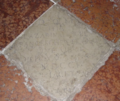Church Floor Artifact
This article contains information on a typical Church Floor Artifact. For a list of Churches, see Churches. For a more information on the artifacts, see Church Floor Artifacts.
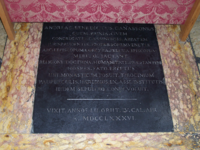 | |
| Total Number of Artifacts | 2221 |
|---|---|
A church floor artifact is an item in a church floor that is visibly different from the surrounding floor and is classified as either a tomb or a plaque. Church Floor Artifacts are distinguished from the rest of the floor as they are often a different stone color or tile pattern and/or contain inscriptions. In addition to Istria Stone and Verona Red Marble, which are the most common floor materials, church floor artifacts often are made of rarer stones and marbles such as Carrara Marble, Greek Marble, Black Marble and other colored marbles and stones.
Classification
There are two types of artifacts found in the Churches of Venice: tombs and plaques. Most artifacts have inscriptions honoring the deceased's life or marking a significant event in the church's history.
Tombs

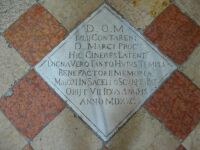
A tomb, or tomba, is the most common type of floor artifact and marks the location of a burial. Due to health concerns and flooding, the body may have been moved and may no longer be in the church. A tomb marker is either a large rectangle or small square, depending on the type of burial and the wealth of the family. All tombs contain some amount of inscription, but the amount of information included ranges from a full obituary to simply DOM, which stands for "Deo, Optimo, Maximo (to God, the Best, the Greatest)" or "Domino, Optimo, Maximo (the Lord, the Best, the Greatest)." These are the mottoes of the Benedictine order. [1] Both types of tombs are shown here.
Plaques

A plaque, or placca, is the second type of artifact. A plaque has an inscription that contains important information pertaining to the church, such as the name of a person who donated money towards the construction or restoration or year of the completion. More importantly, they do not mark the final resting place of someone. Plaques are less common than tombs and are often smaller. An example can be seen to the left.
Condition Evaluation
Worcester Polytechnic Institute teams of researchers evaluated the artifacts on five types of damage. The five types of damage are fading and wear, text readability, cracks, holes, and joint gaps. Each type of damage was evaluated on an individual scale, however in all five cases, the higher the rating, the more severe the damage. A description of each type of damage is listed below.
Fading and Wear
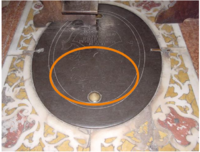
Every artifact is subject to fading and wear by either human intervention or natural causes. The amount an artifact has worn or faded is given a numerical value on a scale from 0 to 4.
0 – The artifact has no fading or wear. It is in perfect condition.
1 – The artifact is somewhat worn. There is possible need for restoration due to evident wear and tear although color and/or design are still visible.
2 – Artifact is moderately worn or faded. It is in need of restoration as the color and/or design of the artifact are not completely visible.
3 – The artifact is extremely worn. Immediate restoration is needed due to the barely visible color and/or design.
4 – The artifact is unrecoverable. The artifact has lost all signs of color and design.
Text Readability
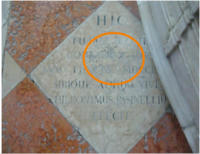
The text readability of an artifact is based upon the condition of each letter. The letters are judged on a 1 - 3 scale, where 1 is considered perfectly readable. Many church floor artifacts contain inscriptions that have been worn down since it was first engraved. In some cases, the text is the only source of information regarding births, deaths, and other facts of Venetian religious history. The assessment of the letters are counted and ranked according to the following:
1 – Perfectly readable letters. There must be no damage on the letter whatsoever to be in this category. These letters are given the lowest weight because they require no restoration.
2 – Letters are readable, but slightly damaged. In this category, the letters are legible but have some damage.
3 – Letters which are completely unreadable. Most of the letter is gone because of water damage or wearing.
The number of individual letters in each of these categories are divided by the total number of letters on the entire inscription and multiplied by one hundred in order to find a percentage of letters in each category. These percentages are then weighed against each category above.
Cracks

Cracks are a serious concern to the structural integrity of the artifact because they indicate weakness in the floor or artifact and can be problematic. For example, if a significant amount of weight were to be put on an artifact with a crack in it, the artifact could sustain more damage due to its already weakened state. When the cracks are assessed, several factors are taken into consideration, including the size of the cracks and the likelihood for it to become larger. After identifying the cracks in an artifact, they are then counted and given a rating from 0-4, corresponding to the percentage of the artifact which is cracked.
Holes
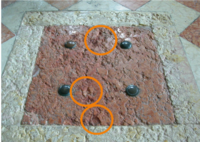
Holes are a form of surface damage that can affect both the text readability and physical integrity of the artifact. A hole was assessed as pitting on the surface where a chunk of the stone has been removed rather than a hole that goes through the entire artifact. The overall amount of surface that contains holes or is pitted contributes to the 0-4 rating the artifact receives. The number of holes with a depth greater than 1.5 centimeters are also counted and considered as a significant contribution to the overall rating of the artifact.
Joint Gaps
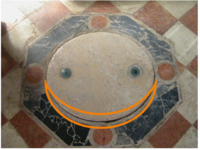
A joint gap is when the artifact is separated from the floor slightly. Gaps may have occurred when the artifact was first laid in the floor, as artifacts were added after the floor had been constructed. Another way gaps occur are from settling of the building, or shifting in the floor, causing the stones to no longer lay flush to one another. Additional shifting could cause more damage to the artifact or the surrounding floor. If an artifact is found to have a joint gap, the length and width of the jap is measured in order to find the total area which is in need of repair.[2]
Condition Ranking
In order to create a ranked list of artifact damage, an equation that takes into account the five different types of damage assessed was developed by a team of researches from Worcester Polytechnic Institute. The equation was developed through experimentation with different weights in the equation so that the scores would acurately depict the condition of the artifact according to the picture provided.
(0.30)(Fading and Wear) + (0.25)(Text Readability) + (0.20)(Cracks) + (0.20)(Holes) + (0.05)(Joint Gaps)
This equation provides a numerical representation of an artifact's condition on a scale from 0-1. Similar to the individual type of damage scores, the higher an artifact's ranking value, the more damage it has sustained.
- Fading and Wear received the highest weight of 30%, as it is an assessment of the overall surface damage of the artifact, and therefore covers the most amount of information about the artifact's condition.
- Text Readability then received a weight of 25%, because text is the component of the artifact from which information about the city's history can be extracted, and therefore deserves a significant contribution to the overall assessment of the artifact.
- Cracks received a weight of 20%, as it effects the structural integrity of the artifact. An artifact's stability is an important contribution to the safety of the entire church floor, not just the artifact and an unsteady floor puts parishioners in danger, and needs to be addressed.
- Holes also received a weight of 20% because holes, while not common, effect the surface of the artifact, and therefore could obstruct the text on the artifact.
- Joint Gaps are weighted with only 5%, because the gaps are not very large, and the information that can be gathered from the artifact is not effected by a gap.
When all is considered, the equation produces a single condition value, between 0-1. This equation and condition evaluation was developed for this website and is not recognized by other outside organizations.[3]
Condition Categories
After using the previous equation to standardize the rankings assigned to each artifact, the values were divided into five categories. This was done to ease understanding of the results by giving the numbers quantitative values. Having only five categories also eases comparison between artifacts, to gauge a single artifact's condition in relation to the rest in the city.
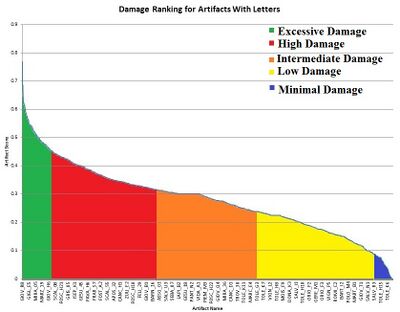
The five categories of damage ranking are excessive damage, high damage, intermediate damage, low damage and minimal damage. Below is a description of each accompanied by two example pictures.
- Excessive Damage: The artifact is too far degraded that no more information would be saved if the artifact were to undergo restoration. While text can no longer be extracted from the artifact, it should still receive restoration attention to maintain the quality of the floor.
- High Damage: The text is still slightly readable, but is in danger of being worn to an extent that would lose all information it contains. The artifact is in need of preservation in order to maintain the image or text visible on the artifact.
- Intermediate Damage: The artifact has sustained some damage in any of the five damage categories, but the text is still mostly readable. Preservation would benefit the artifact, but it is not yet in critical condition.
- Low Damage: The artifact has sustained very little damage. The text is nearly flawless and only minimal efforts would need to be made in order to maintain the artifact in its current condition.
- Minimal Damage: The artifact has hardly any damage and all of the text and artwork is readable. At this time, there is no need for preservation.[4]
See Also
References
- ↑ http://www.alsirat.com/symbols/latin.htmlhttp://www.alsirat.com/symbols/latin.html
- ↑ Santos,Luiz G., Petrowski,Craig Peter, Kristant,Elaine Hazel, Delaive,Amanda Leigh. The Church Floors in Venice, Italy -- an Archeological Study and Analysis. An Interactive Qualifying Project for Worcester Polytechnic Institute. 2002.
- ↑ Dechaine, Danielle, Hennessey, Meghan, Orszulak, Jeffrey, Rullmann, Kevin. Treasures Underfoot: Preserving Venice's Church Floor Artifacts. An Interactive Qualifying Project for Worcester Polytechnic Institute. 2012.
- ↑ Dechaine, Danielle, Hennessey, Meghan, Orszulak, Jeffrey, Rullmann, Kevin. Treasures Underfoot: Preserving Venice's Church Floor Artifacts. An Interactive Qualifying Project for Worcester Polytechnic Institute. 2012.
Bibliography
- Dechaine, Danielle, Hennessey, Meghan, Orszulak, Jeffrey, Rullmann, Kevin. Treasures Underfoot: Preserving Venice's Church Floor Artifacts. An Interactive Qualifying Project for Worcester Polytechnic Institute. 2012
- S. Hoey, M. Kahan, P Marchetti, K Mazza. Convents, Palaces and Churches: Transformation of Historic Buildings and the Impact on Venice’s Neighborhoods. An Interactive Qualifying Project for Worcester Polytechnic Institute. 2003.
- Santos,Luiz G., Petrowski,Craig Peter, Kristant,Elaine Hazel, Delaive,Amanda Leigh. The Church Floors in Venice, Italy -- an Archeological Study and Analysis. An Interactive Qualifying Project for Worcester Polytechnic Institute. 2002.
External Links
None



